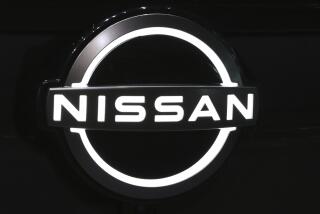Side Air Bags Largely Safe, Auto Industry Panel Finds
- Share via
WASHINGTON — Side air bags--the latest in high-tech auto safety devices--are providing effective protection in actual crashes while largely avoiding inadvertent injuries to passengers, an auto industry technical group reported Thursday.
The panel, composed of experts from the auto industry and an insurance research center, also released proposed testing requirements for side air bags. If adopted by car makers, these requirements would reduce greatly the risk of serious harm to children and small-stature adults, the panel said.
Front air bags--required by the government--are estimated to have saved thousands of lives. But they deploy with such force that they have also killed 162 people, including 96 children, mostly in low-speed crashes.
Given that history, safety concerns were quickly raised as side air bags were introduced in recent years. An estimated 100 of 250 new vehicle models now offer them as an option or standard equipment, and that share is expected to grow. Many passenger car owners view side air bags as a last line of defense if they are broadsided by big sport-utility vehicles or pickup trucks. SUV owners may want them to help prevent ejection during a rollover.
But there is no federal mandate for side air bags nor are they subject to government safety standards. And last year the National Highway Traffic Safety Administration took the unusual step of calling on the industry to fashion its own safety standards, reasoning that it would be faster than a cumbersome regulatory process.
Consumer groups, mistrustful of the industry, objected that the government was shirking its duty.
“I have no confidence in this process,” said Clarence Ditlow of the Center for Auto Safety. “It’s ridiculous to think that industry, which has been killing kids with front air bags, is going to protect them with side air bags.”
But the auto industry took up the invitation, and the technical panel was formed.
“We’re not coming into a situation like we had with front air bags,” said panel chairman Adrian Lund of the Insurance Institute for Highway Safety. “We’re fortunate we don’t have a problem out there and we’re trying to prevent that.”
The highway safety agency reports, released by the panel, show that there have been no deaths attributed to side air bags. The agency closely investigated 50 crashes in which side air bags were deployed. Only one serious injury was blamed on a side air bag--broken ribs suffered by an elderly man who apparently was sitting too close to a door-mounted air bag.
Two of the cases involved children, and agency investigators found that, on balance, the side air bags helped protect them. “The conclusion was that the side air bags provided protection--but there also were some bruises,” said Lund.
Side crashes are less frequent than head-on crashes, but they can be more lethal. In a side impact, there is less space between a vehicle’s occupant and the intruding hood of another vehicle. Serious head and chest injuries are a common consequence. In 1998, nearly 9,500 people died in vehicles struck from the side.
Side air bags offer the possibility of preventing some of those injuries. Several designs are currently in use. Some are mounted in doors, others in seats and still others along the roof rail. Some deploy as shields that protect the head and chest, others look like accordion curtains and others have sausage-like shapes.
A few car makers also offer side air bags in back seats. However, this remains controversial because the risk to children of the bags’ forceful deployment cannot be totally eliminated.
The technical panel focused on reducing that risk as much as possible. It recommended a series of 15 tests, using dummies representing children and shorter adults. Some of the tests try to capture the restlessness of children. In one, a child dummy kneeling next to the air bag is supposed to be playing peek-a-boo with another child in the back seat.
The panel then set limits on head, neck, chest and other injuries that the dummies could receive from the air bag.
“The group’s work reflects the best current information on how to measure the risk of significant injury from the air bag inflation itself and assure that it is very small--but the risk cannot be made zero,” the panel’s report noted.
That report is now being distributed to industry, government and consumer groups for comment before the recommendations become final. Industry is expected to adopt them, and the government could use them as the basis for a safety standard.
The highway safety agency issued a statement calling the recommendations “an excellent first effort.” But it said that it is conducting its own side air bag research and will take action if the industry’s measures falter.






